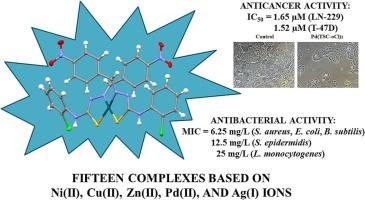Structural studies and biological activity of the new Ni(II), Cu(II), Zn(II), Pd(II), and Ag(I) thiosemicarbazone-based complexes
IF 3.2
2区 化学
Q2 BIOCHEMISTRY & MOLECULAR BIOLOGY
引用次数: 0
Abstract
Three new chloro-substituted nitrophenyl-based thiosemicarbazones, namely: HTSC-oCl, HTSC-mCl, and HTSC-pCl (where HTSC-Cl = N-chlorophenyl-2-[(4-nitrophenyl)methylidene]hydrazine-1-carbothioamide; −o/−m/−p = −ortho/−meta/−para), and fifteen of their Ni(II), Cu(II), Zn(II), Pd(II) and Ag(I) complexes were synthesized and studied in terms of physicochemical properties and biological activity. All three ligands and six complexes were studied using single crystal X-ray diffraction analysis, revealing the N,S-binding mode and deprotonation of the organic ligand. Of all compounds, Cu(TSC-oCl)2, Cu(TSC-mCl)2, and Pd(TSC-oCl)2 exhibited the best anticancer activity on LN-229 and T-47D, reaching IC50 values equal to 2.64 ± 0.57 μM, 1.65 ± 0.14 μM, and 1.52 ± 0.12 μM, respectively. The mechanism of action studies revealed distinct characteristics for Cu(II) and Pd(II) complexes, with Cu(TSC-oCl)2 and Cu(TSC-mCl)2 strongly activating antioxidant genes and acting as potent ROS producers, while Pd(TSC-oCl)2 appears to successfully target the cells' DNA. Most importantly, all three complexes were less toxic toward healthy BJ cells. In addition to that, several bacteria strains: S. aureus, S. epidermidis, B. subtilis, and E. coli were found to be susceptible toward some of the tested complexes, particularly those based on Cu(II), Zn(II), Pd(II), and Ag(I), with MIC values reaching 6.25 mg/L.

新型镍(II)、铜(II)、锌(II)、钯(II)和银(I)硫代氨基脲配合物的结构和生物活性研究
三种新的氯取代硝基苯基硫代氨基脲,即:HTSC-oCl、HTSC-mCl和HTSC-pCl(其中HTSC-Cl = n -氯苯-2-[(4-硝基苯)甲基]肼-1-碳硫酰胺;合成了15种Ni(II)、Cu(II)、Zn(II)、Pd(II)和Ag(I)配合物,并对它们的理化性质和生物活性进行了研究。利用单晶x射线衍射分析对这三种配体和六种配合物进行了研究,揭示了有机配体的N、s结合模式和去质子化。其中Cu(TSC-oCl)2、Cu(TSC-mCl)2和Pd(TSC-oCl)2对LN-229和T-47D的抑癌活性最强,IC50值分别为2.64±0.57 μM、1.65±0.14 μM和1.52±0.12 μM。作用机制研究揭示了Cu(II)和Pd(II)复合物的不同特征,Cu(TSC-oCl)2和Cu(TSC-mCl)2强烈激活抗氧化基因并作为有效的ROS产生物,而Pd(TSC-oCl)2似乎成功靶向细胞的DNA。最重要的是,这三种复合物对健康BJ细胞的毒性较小。此外,金黄色葡萄球菌(S. aureus)、表皮葡萄球菌(S. epidermidis)、枯草芽孢杆菌(B. subtilis)和大肠杆菌(E. coli)等菌株对部分测试复合物敏感,特别是铜(II)、锌(II)、钯(II)和银(I)的复合物,其MIC值达到6.25 mg/L。
本文章由计算机程序翻译,如有差异,请以英文原文为准。
求助全文
约1分钟内获得全文
求助全文
来源期刊

Journal of Inorganic Biochemistry
生物-生化与分子生物学
CiteScore
7.00
自引率
10.30%
发文量
336
审稿时长
41 days
期刊介绍:
The Journal of Inorganic Biochemistry is an established international forum for research in all aspects of Biological Inorganic Chemistry. Original papers of a high scientific level are published in the form of Articles (full length papers), Short Communications, Focused Reviews and Bioinorganic Methods. Topics include: the chemistry, structure and function of metalloenzymes; the interaction of inorganic ions and molecules with proteins and nucleic acids; the synthesis and properties of coordination complexes of biological interest including both structural and functional model systems; the function of metal- containing systems in the regulation of gene expression; the role of metals in medicine; the application of spectroscopic methods to determine the structure of metallobiomolecules; the preparation and characterization of metal-based biomaterials; and related systems. The emphasis of the Journal is on the structure and mechanism of action of metallobiomolecules.
 求助内容:
求助内容: 应助结果提醒方式:
应助结果提醒方式:


